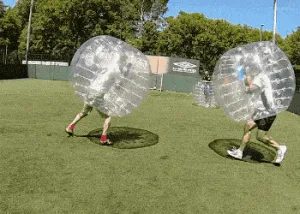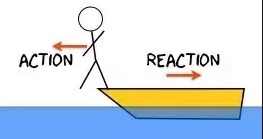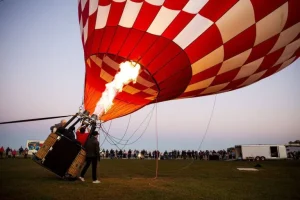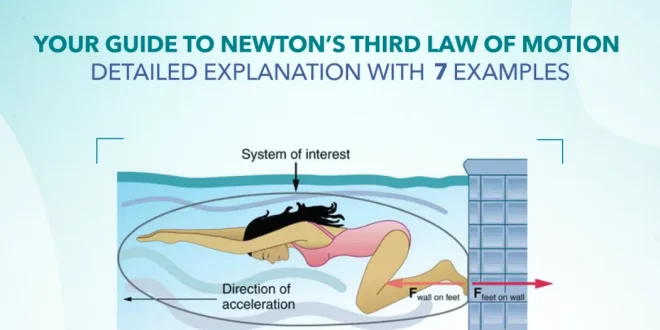Last Updated on October 11, 2025 by Muhamed Elmesery
The laws of physics are prominent in our everyday life, as they permeate, govern, and fully control every step we take and every move we make. The various applications of Newton’s third law of motion form a good example to recall in this context, especially within the boundaries of our solar system.
In this article, we will elaborately discuss the nature of this law, its equation, and its importance in our daily life, in addition to mentioning some real life examples of Newton’s third law.. Let’s take a look!
try now Newton's Third Law of Motion at Praxilabs
Table of Contents
What Is Newton’s Third Law of Motion?
In 1687, and throughout his Philosophiae Naturalis Principia Mathematica masterpiece, widely known as the Principia, Sir Isaac Newton proposed his renowned three laws of motion, commonly named after him. The laws mainly deal with the term “force,” but do you know what the types of forces are?
Forces exist in two forms, either as a result of contact interactions, i.e., normal, tensional, frictional, and applied forces; or as a result of actions-at-a-distance interactions, existing in the form of electrical, electrical, and magnetic forces. In this law, Isaac Newton described any two objects that are interacting to be exerting mutual forces upon each other.
That is to say, if you are reading this article whilst sitting on a chair, therefore your body will be exerting a downward force on the chair, and so does the chair but in the upward direction.. YES! The chair too exerts force on you! Not just that, but during this battle between your body and the chair, the Earth will be also exerting a downward gravitational force on both of you!! And guess what? True.. both of you will be resisting being swallowed to the center of the Earth, and you will be exerting equally upward force.
Newton’s Third Law Equation
“Forces come in pairs.” That is how you can resemble Newton’s third law in your common everyday language. The two equal forces exerted are of the same magnitude, but in opposite direction, known as: action and reaction forces.

It is the elixir of physics for every law or proven logical statement to have a mathematically detailed equation. Thus, Newton’s third law equation states:
FA = – FB
where:
- FA: the force exerted by the first object on the second, in a certain direction.
- FB: the force exerted by the second object on the first, but in an opposite direction.
A more sophisticated, yet useful formula, is given by
m1a1 = – m2a2
where:
- m1: the mass of the first object.
- a1 : the acceleration of the first object.
- m2: the mass of the second object.
- a2 : the acceleration of the second object.
Check Your Understanding!
Q1: A 60 kg person pushes a 10 kg box with a force of 30 N to the right. What is the force on the person?
A1: 30 N to the left
Q2: A 60 kg person pushes a 10 kg box with a force of 30 N to the right. What is the acceleration of the box?
A2: Only concerned with the force and acceleration of the box, represented by subscript 2
F2 = 30 N Right F2 = m2a2
m2 = 10 kg
a2 = ? a2 = F2 / m2 a2 = 30/10 a2 = 3 m/s2 right
Q3: A 60 kg person pushes a 10 kg box with a force of 30 N to the right. What is the acceleration of the person?
A3: Only concerned with the force and acceleration of the person, represented by subscript 1
F1 = 30 N Left F1 = m1a1
m1 = 60 kg
a1 = ? a1 = F1 / m1 a1 = 30/60 a1 = 0.5 m/s2 left.
Importance of Newton’s Third Law of Motion
If you place your physics book on a table, the book will stay still on the table unless you move it or a force moves it. Now think what law of motion keeps your book still?
This is one example of Newton’s third law of motion in everyday life that undisputedly dominates all our daily activities.
One of Newton’s third law axes of importance lies in it being the reason behind us knowing another essential law in physics: momentum is conserved throughout collisions between objects. That is to say, even if the occurring interaction is very short lived, and we do not know any of the forces magnitudes or directions while objects are in contact, in addition to being pretty sure that these forces are not constant during the contact, we can still solve the problem by analyzing what the two objects do and how they act after the collision because momentum is conserved and because the third law applies.
How Is Newton’s Third Law of Motion Useful in Our Real Life?
A variety of action-reaction force pairs are evident in nature, and in our real life. Here are 7 applications of Newton’s third law of motion:
- Walking: when you walk, you push the street; i.e., you apply an action force on the street’s ground, and the reaction force moves you forward.
- Gun Firing: when someone fires a gun, the action force pulls the bullet outside the gun, and the reaction force pushes the gun backward.
- Jumping from a boat: the action force is applied on the boat, and the reaction force pushes you to land. Parallelly, the action force pushes the boat backward.
- Slapping: when you slap someone, your hand feels pain and so does the cheek of the victim. The pain in the cheek is due to action force, and the pain in the palm is due to reaction force.
- Bouncing a ball: when a ball hits the ground, the ball applies an action force on the ground. The ground applies a reaction force and the ball bounces back.
- Flight motion of a bird: the wings of the bird push air downwards as action force, and the air pushes the bird upwards as reaction force.
- Swimming of a fish: the fish’s fins push water around it backward as an action force, and the water applies a reaction force by pushing the fins forward, thus the fish.
To totally visualize your understanding, PraxiLabs advise you would check this quick video funnily discussing Newton’s third law of motion examples in everyday life, with explanation.

Create your FREE account now to try the virtual experiments
Technology Uses Newton’s Second and Third Laws of Motion
As we knew earlier, Sir Isaac Newton developed all the three laws of motion; the second law states that: acceleration of an object is directly proportional to and in the same direction as the net force acting on the system and inversely proportional to its mass. This law is mathematically denoted as:
Fnet = ma
Newton’s second law is pivotal in the applications of science and engineering, as it connects the dots between force and motion in one formula. By calculating the acceleration of an object and therefore its velocity and position, we can determine its trajectory, thus knowing where it will be at any given time.
Engineers also use Newton’s second law to calculate forces acting upon stationary objects. For a non-moving object the acceleration is zero; hence the sum of the forces acting on the object is also zero. Engineers apply Newton’s second law in designing structures to calculate the forces acting on joints in the framework of buildings and bridges.
Elevators are another suitable example, as they follow Newton’s second law of motion according to which the ropes’ tension force is determined to limit the acceleration.
Newton’s third law explains how balloons and rocket engines work. When the neck of an inflated balloon is released, the stretched rubber material pushes against the air in the balloon, and the air rushes outside the neck of the balloon, whereas the action of the air rushing from the balloon pushes against the balloon itself, causing it to move in the opposite direction.

Speaking of rocket engines, when the rocket’s fuel is burnt, hot gasses are produced. These gasses rapidly expand and are forced out of the back of the rocket, where this is known as action force. At the same time, the gasses exert an equal and opposite force on the rocket itself, scientifically known as the reaction force, and this force pushes the rocket upward.
Wheels and levers both follow Newton’s third law of motion, as reaction force is the driving mechanism for these two gadgets. Gym equipment is mostly pulley-based; therefore Newton’s third law of motion is the law in action while you do your workout.
Newton’s Third Law of Motion Examples in Sports
It seems that this third law literally controls everything around us, from rocket science to the motion of animals, to humans everyday life, to the point that it literally controls how sportsmen and sportswomen perform their athletic activities. Since Newton’s third law is an “action-reaction” law, it is a key law in different fields of sports. It also works hand-in-hand with the conservation law of momentum. And in sports fields, this mostly includes many forms of inelastic collisions and elastic ones in some rare cases.
A hockey puck will keep on sliding on the ice until it hits the wall, or it is hit by another player. In order to jump off a raft, it requires swimmers to move forward through the air, and the raft to move backwards through the water. Another sportive example where Newton’s third law dominates is shooting ranges, as shooting activities wouldn’t have existed without the action-reaction rule.
To know how Newton’s third law affects players’ motion and why momentum can keep them moving or stop them in their tracks, watch this Science of NFL Football video where professors explain how players get the utmost benefit from physics laws in football fields.
In case you would like to read more about other Newton’s laws of motion, read this article discussing Newton’s first law of motion with equations and examples, or this article reviewing Newton’s second law.
If you would like to learn more about all of Newton’s laws of motion, you can read this article for more information, equations and examples about the first law, or see this article that reviews the second law and its most common applications in a smooth way.
 PraxiLabs A virtual world of science
PraxiLabs A virtual world of science






